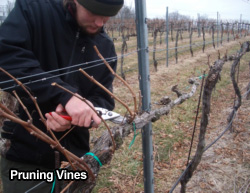
Stage 1 - Pruning (Dec-Feb)
The Maltese islands have a much warmer climate compared to other countries. This helps us to prune the grapevine in early winter. Pruning is done as far down to the main stem as possible. The aim is to get rid of all of last year's growth. The grapevine is an extremely vigorous grower, and pruning it will only motivate it to grow more. When pruning a grapevine, we always cut at an angle, which allows for better circulation and air flow into the plant.
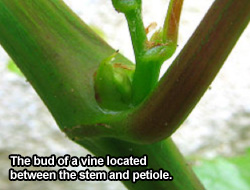
Stage 2 – Bud Break (March-April)
The grape starts its annual growth cycle in the spring with bud break. If the vine had been pruned during the winter, the start of this cycle is signaled by a "bleeding" of the vine. This bleeding occurs when the soil begins to warm and osmotic forces push water, containing a low concentration of organic acids, hormones, minerals and sugars, up from the root system of the vine and it is expelled from the cuts (or "wounds") left over from pruning the vine. During this period a single vine can "bleed" up to 5 litres of water.
Tiny buds on the vine start to swell and eventually shoots begin to grow from these buds. Buds are the small part of the vine that rest between the vine's stem and the petiole (leaf stem). These buds appear in the summer of previous growth cycle green and covered in scales. During winter dormancy they turn brown until the spring when the vine begins the process of bud break. Inside the buds there are usually three primordial shoots. The first sign of green in the vineyard emerges in the form of tiny shoots. The energy to facilitate this growth comes from reserves of carbohydrate stored in roots and wood of the vine from the last growth cycle. Eventually the shoots sprout tiny leaves that can begin the process of photosynthesis, producing the energy to accelerate growth. In warm climates like ours, after about 4 weeks the growth of the shoots starts to rapidly accelerate with the shoots growing in length an average of 3 cm (1 in) a day.
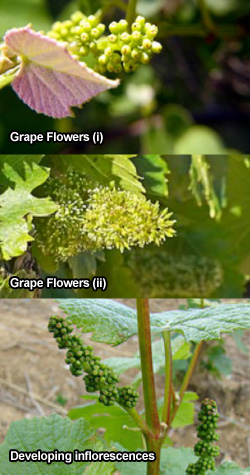
Stage 3 – Flowering (April)
Flowering: Approximatley 40-80 days after bud break, depending on the temperature, the process of flowering starts.This flowering starts with small flower clusters appearing on the tips of the young shoots looking like buttons. Flowering occurs when average daily temperatures stay between 15–20 °C.
A few weeks after the initial clusters appear, the flowers start to grow in size with individual flowers becoming observable. This stage of flowering is the stage when pollination and fertilization of the grapevine takes place.
At the beginning of this flowering process, the only part that is visible is the fused cap of petals known as the calyptra. Shortly afterwards the calyptra is shed, liberating the pollen from the anthers of the stamen. Wind and insects generally play only a small role in aiding pollination, with the process being mostly self contained within the vine.
During this process of pollination and fertilization, the pollen fertilizes the ovary which produces seeds as the flower begins the transformation into a grape berry, encapsulating the seed. The resulting product is a grape berry, containing 1-4 seeds. Detrimental weather (cold, wind & rain) can severely affect the flowering process, causing many flowers not to be fertilized.
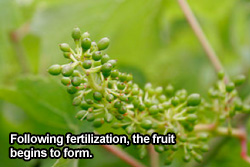
Stage 4 – Fruit Set (May)
The stage of fruit set follows flowering almost immediately. This is when the fertilized flower begins to develop a seed and a grape berry to protect the seed. This stage is very critical for wine production since it determines the potential crop yield. Not every flower on the vine gets fertilized. The unfertilized flowers eventually end up falling off the vine. The percentage of fertilized flowers averages around 30 but can get as high as 60.
Climate and the health of the vine play an important role with low humidity, high temperatures and water stress having the potential of severely reducing the amount flowers that get fertilized.
Coulure occurs when there is an imbalance of carbohydrate levels in the vine tissues and some berries fail to set or simply fall off the bunch. Varieties like Grenache and Malbec are prone to this abnormal fruit set.
Millerandage occurs when some fertilized flowers do not form seeds but only small berry clusters. Grape berry size depends on the number of seeds so berries with no seeds will be significantly smaller than berries containing seeds. On one cluster there may be berries of various sizes which can create problems during winemaking due to the varying "skin to pulp" ratio among the grapes. This can be caused by vine disease, such as fanleaf, or by a boron deficiency in the vine
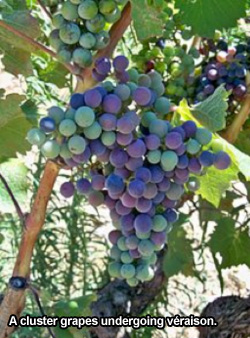
Stage 5 – Verasion (June-July)
Following fruit set, the grape berries are green and hard to the touch. They have very little sugar and are high in organic acids. They begin to grow to about half their final size when they enter the stage of veraison. This stage signals the beginning of the ripening process and normally takes places around 40-50 days after fruit set. During this stage the colours of the grape take form. The new colours red/black or yellow/green depend on the grape varieties. This color changing is due to the chlorophyll in the berry skin being replaced by anthocyanins (red wine grapes) and carotenoids (white wine grapes). In a process known as engustment, the berries start to soften as they build up sugars. Within six days of the start of veraison, the berries begin to grow dramatically as they accumulate glucose and fructose and acids begin to fall.
The onset of veraison does not occur uniformly among all berries. Typically the berries and clusters that are most exposed to warmth, on the outer extents of the canopy, undergo veraison first with the berries and clusters closer to the trunk and under the canopy shade undergoing it last. There are some factors in the vineyards that can control the onset of veraison, limited water stress and canopy management that creates a high "fruit to leaf" ratio can encourage veraison. This is because the vine is biologically programmed to channel all its energies and resources into the berries, which houses its seedling offspring, so that they may have a better chance of survival. Conversely, very vigorous wines with lots of leaf shading for photosynthesis and water supply will delay the start of veraison due to the vines energies being directed towards continued shoot growth of new buds.
For the production of high quality wine, it is considered ideal to have an earlier veraison. During this period the cane of the vine starts to ripen as well changing from green and springing to brown and hard. The vines begins to divert some of its energy production into its reserves in preparation for its next growth cycle.
Stage 6 – Harvesting (August-September)
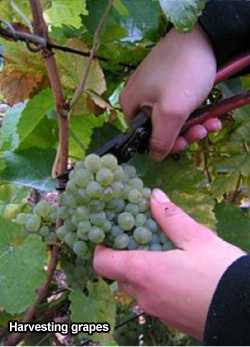
In the vineyard, the antepenultimate event is the harvest in which the grapes are removed from the vine and transported to the winery to begin the wine making process. The time of harvest depends on a variety of factors; most notably the subjective determination of ripeness. As the grape ripens on the vines, sugars and pH increase as acids (such as malic acid) decrease. Tannins and other phenolics also develop which can affect the flavors and aromas in the resulting wine. The threat of detrimental weather and vine diseases (such as grey rot) can also play a role in the time table. The balance of all these factors contributes to when a winemaker or vineyard manager decides that it is time to harvest.